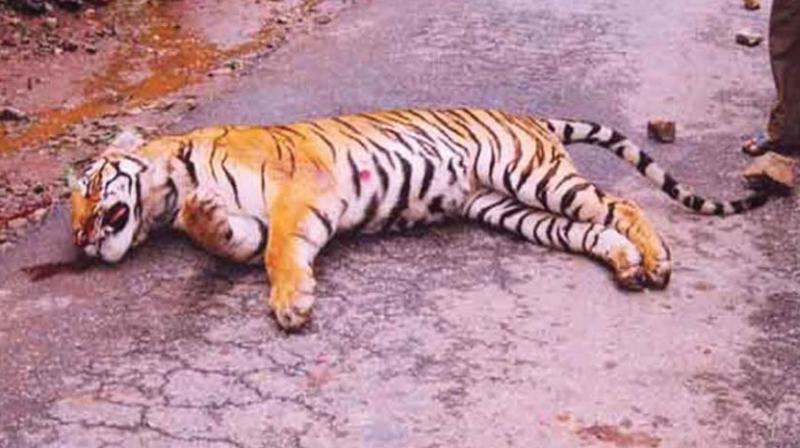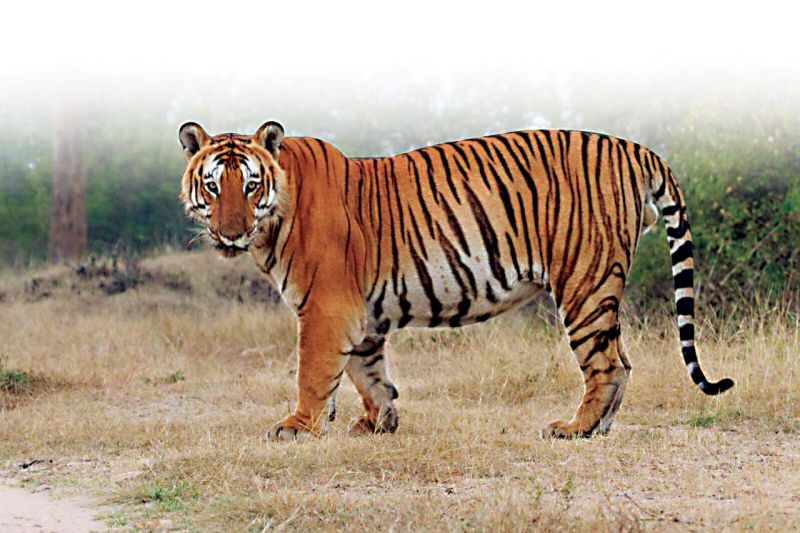Tiger, tiger burning bright... but not in Karnataka
Nevertheless, forest officers aren’t too unhappy with the tiger count since it has seen a rise by 118 compared to the previous count.

There has always been an intimate connect between the royals of yesteryears and tigers and the Mysore royals were no exception, doing everything possible to safeguard the big cat for posterity so that Karnataka would always have a place of pride in the hearts of animal lovers who adore the striped wonder. In recent decades, the love for the tiger and conservation efforts have gained momentum helping its population in the state record a steady rise from 290 in 2006 to 524 in 2018. But now, tiger lovers have reason to be worried after a survey placed Karnataka second to Madhya Pradesh in the number of tigers with the state losing its numero uno position. Tiger reserves like Bandipur and Nagarhole are no doubt ideal retreats for them and have been favourite destinations for those who can’t rest till they have their rendezvous with the big cat. But not all is perfect at these reserves—for instance temples located deep inside the forests have to be shifted to avoid human interference and so do tribal families settled inside the forests. On the positive side, tiger reserves like Bandipur, Bhadra and Nagarahole have imposed a night traffic ban to help nocturnal animals cross from one side of the road to the other which was a much needed step considering the number of road kills in recent years. M.B. Girish examines the state of the big cat in these reserves and finds out what more needs to be done to help Karnataka top in the number of tigers—an honour it enjoyed not so long ago.
The All India Tiger Status-2018 released by Prime Minister Narendra Modi on July 29 to mark International Tiger Day came as a jolt to forest officers with the state losing its top ranking in tiger population to Madhya Pradesh which saw its tiger numbers shoot up from 308 in 2014 to 526 in 2018 while Karnataka’s tiger population could only rise from 406 to 524 in the 2018 tiger estimate.
Nevertheless, forest officers aren’t too unhappy with the tiger count since it has seen a rise by 118 compared to the previous count. Since, the all India estimation started in 2006, Karnataka has seen a steady rise in its tiger population from 290 in 2006 to 300 in 2010 and to 406 in 2014 when it topped in the country with the magnificent animal spread across five tiger reserves and some non-protected areas.
Bandipur obviously is the cynosure of all eyes with conservation efforts beginning as early as the 1930s during the rule of the Maharajas of Mysore. It now has 139 plus tigers in a vast area extending across 1,027 sq km with 12 ranges and a buffer zone spread across Chamarajanagar and Mysuru districts.
Conservator of Forests and Bandipur Park director Balachandra says security measures and good prey density such as adequate spotted deer, gaur, sambar among other herbivorous animals have contributed to the tiger population. “We have a tiger for less than every 10 sq km in Bandipur,” adds Balachandra.
 Famed tiger of Bandipur ‘Prince’ photographed by retired director of the Park B.B. Mallesh.
Famed tiger of Bandipur ‘Prince’ photographed by retired director of the Park B.B. Mallesh.
The shifting of human settlements from inside Bandipur has helped and so has the night traffic ban from 9 pm to 6 am since February, 2009 on National Highway-67 cutting through the park to link Ooty in Tamil Nadu and on NH-766 connecting with Wayanad in Kerala. According to official figures, before the night traffic ban was imposed, as many as 91 wild animals were knocked down by speeding vehicles inside the park. Road kills have now come down drastically and records say many of the victims now are spotted deer which accounted for 22 of 40 road kills.
Animal lovers even have their favourites at the famed tiger reserve and so does former Bandipur director, B.B. Mallesh who recounts how a tiger fondly called Prince by visitors, was his favourite. “It was strong during its prime and even killed four tigers in territorial clashes. Prince was an ideal ambassador for Bandipur,” he recalls.
 Wild life enthusiast Satish Gowda donates rechargeable torches to APC staff in Bhadra.
Wild life enthusiast Satish Gowda donates rechargeable torches to APC staff in Bhadra.
Another tiger reserve known for its healthy tiger density is Nagarahole National Park spread across Mysuru and Kodagu covering 853 sq km. If Bandipur has more tigers, Nagarahole is famed for the highest density of tigers per sq km in the country. “It’s a tiger for every 6 sq km in the park and you can hardly miss the stripes,” says a ranger. According to forest officials, what has helped the tiger numbers jump are effective patrolling, adequate prey base and space for animals while points of concern are timber felling, poaching of herbivorous animals and illegal grazing of cattle which pose a threat to the wildlife population. As per the 2014 tiger estimate, there were 110 tigers in Nagarahole and the numbers could have jumped in 2018 with the exact figures likely to be available later this month.
Like Bandipur, Nagarahole has in place a night traffic ban on two routes to Kerala-Mysuru-Mananthavady road and Veeranahoshalli-Kutta road from 6 pm to 6 am to avoid road kills.
Another tiger reserve located in Chamarajanagar is Biliranga Tiger Reserve spread across 574 sq km which accounts for about 63 tigers while the latest figure is yet to be released by National Tiger Conservation Authority (NTCA). Its director Shankar attributes the growing tiger numbers to effective patrolling of the reserve, curbs on poaching, a good prey base for tigers and a continuous terrain which allows free movement of animals to neighbouring MM Hills, Satyamangalam in Tamil Nadu and Wayanad in Kerala. According to him, there is a tiger in BRT for every 10 sq km.
Bhadra Tiger Reserve in Chikkamagaluru is spread over 500 sq km and is estimated to have about 33 tigers, up from about 17 in 2014. Its director Dhananjaya says that apart from checks on poaching, illegal grazing inside the park, timber smuggling and collection of firewood by locals, the shifting of many human settlements has contributed to the increasing tiger population. To make sure local residents do not have to suffer because of tigers or leopards killing cattle, wildlife enthusiasts such as former honorary wildlife warden of Chikkamagaluru Satish Gowda compensate them from their personal funds whenever a cattle kill happens on the periphery of Bhadra reserve. “This will ensure that people do not poison the big cats or try to attack and kill them if they stray out of the park,” Satish Gowda adds.
He has been helping guards at Anti-Poaching Camps in Bhadra reserve by donating rechargeable torches, pressure cookers, shoes among other accessories to help them defend themselves against poachers and smugglers.
There are smaller reserves too like the Kali tiger reserve in Uttara Kannada district which has nine tigers in an area of 1.3 lakh hectares. Its director Basavaraj Patil says that there is scope for increasing the tiger population as the reserve has a higher carrying capacity. As many as 120 families located inside the tiger reserve have been relocated and there are 132 villages including hamlets which need to be shifted out of the reserve to make it free of human interference, he adds.
The reserve has two temples— one at Ulavi which is difficult to relocate and Kavala, a cave temple dedicated to Lord Shiva, which opens for devotees once in a year during Mahashivaratri.
And what are the challenges which forest rangers face while functioning in a tiger reserve? There are many, says Vinay, a Range Forest Officer(RFO) attached to Antarasante in Nagarahole National Park. Besides assigning staff for night patrols, they also have to gather intelligence on movement of poachers and smugglers and on straying of tigers or elephants.
But what matters most are measures to build confidence among villagers so that the big cat can escape a reprisal if cattle are killed in villages on the edges of the park. The best an RFO can do is get the farmer swift compensation which is Rs 10,000 for adult cattle while calves get Rs 5,000.
“Besides, if a tiger strays out of the park, we get down to business even if it is midnight and ensure the animal is driven back to keep the villagers quiet,” says Vinay. The profession has its share of hazards with RFO Raghavendra Agase attacked by a strayed tiger recently outside GS Betta when he was tracking its pug marks. Another RFO, Rudresh, was injured by a tiger in a rescue operation a couple of years ago.
A big cause of worry for animal lovers are the religious rituals held inside Bandipur and Nagarahole National Parks at the many temples. A source says that the heavy influx of devotees into the park even though it may be for only a couple of days, is enough to disturb the flora and fauna. Devotees cook food by felling branches, clean utensils in waterholes used by wild animals and even use loudspeakers to play music inside the tiger reserve!
“In Bandipur alone, there are as many as 21 places of religious importance including a dargah which need to be shifted,” says a source adding that park officials cannot afford to take on the villagers as it would hurt their religious sentiments.
There have also been cases of aged tigers which are too weak to hunt on fast moving prey, targeting slow moving cattle and livestock leading to conflict situations especially in Omkara, and Hediyala, ranges of Bandipur with villagers even poisoning the big cats.
This year, a few villagers on the borders of Gopalaswamy Betta range in Bandipur created a fire destroying vast tracts of forests before it was contained. The fire was an act of retaliation for tigers entering human habitats and preying on livestock.
And how does one stop these man-animal conflicts which could lead to a drastic fall in the big cat’s numbers and endanger their safety? Winning the confidence of people on the borders of Bandipur by educating them on the need to conserve wildlife, is the best way out says Balachandra adding that an NGO has been engaged to interact with villagers on this subject.

